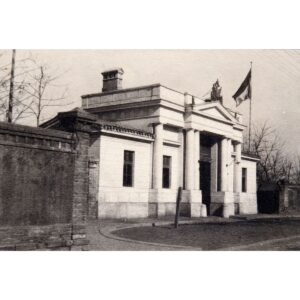Photography The East Church in Beijing
A black-and-white photograph showing St. Joseph’s Church (Dasheng Ruisitang 大聖若瑟堂), also known as East Church (Dongtang 東堂) in Beijing. The church was built in 1904 on the site of its predecessor, a smaller chapel erected by Jesuit missionaries in 1655, which had been destroyed by fire. It is in the so-called Neo-Romanesque style, which incorporates various Chinese architectural and artistic elements. This also distinguishes it from the other three Catholic churches in the Roman Catholic Archdiocese of Beijing. The church is located in Dongcheng District (Dongchengqu 東城區) on Wangfujing Street 王府井. It is still in operation and is the second largest church in Beijing. In 2008, writer Liu Cixin 劉慈欣 used it as a motif in his internationally acclaimed and award-winning science fiction novel Three Body Problem (San Ti 三体).
The original chapel burned down during the Boxer Rebellion in 1900, as did many other Catholic churches in Beijing. Increased ... more
A black-and-white photograph showing St. Joseph’s Church (Dasheng Ruisitang 大聖若瑟堂), also known as East Church (Dongtang 東堂) in Beijing. The church was built in 1904 on the site of its predecessor, a smaller chapel erected by Jesuit missionaries in 1655, which had been destroyed by fire. It is in the so-called Neo-Romanesque style, which incorporates various Chinese architectural and artistic elements. This also distinguishes it from the other three Catholic churches in the Roman Catholic Archdiocese of Beijing. The church is located in Dongcheng District (Dongchengqu 東城區) on Wangfujing Street 王府井. It is still in operation and is the second largest church in Beijing. In 2008, writer Liu Cixin 劉慈欣 used it as a motif in his internationally acclaimed and award-winning science fiction novel Three Body Problem (San Ti 三体).
The original chapel burned down during the Boxer Rebellion in 1900, as did many other Catholic churches in Beijing. Increased construction of new, larger churches in Beijing began in implementation of the 1901 Boxer Protocol (Xinchou Tiaoyue 辛丑條約) agreements, which, among other things, guaranteed the right of “European” emigrants to religious ceremonies.
The photograph is the 40th of 449 photographs of Beijing and its surroundings in the album of Ivan Skušek Jr., purchased during his stay in Beijing (1914–1920). In the handwritten inventory of the album, the photograph is referred to as Dung-Tang (Ost-Kirche). (DZ)





































Do you have a comment or additional information about the subject?